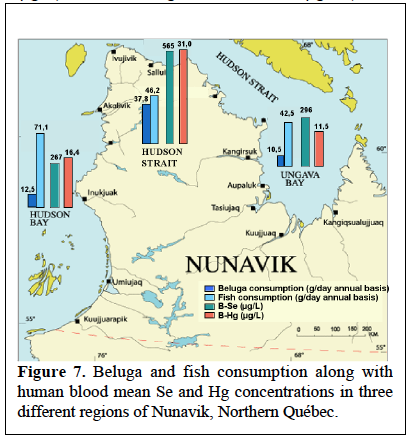|
|

|
|

|
|

|
|
Task 4 - Exposure to metal contaminants for Northern population
Partners in charge:
Eric Dewailly (Nasivvik-Québec, affiliated to partner 1)
This task will aim to make links between metal contaminants in the environment and the exposure of
populations of the circum-arctic by using isotope tracing. The data will be interpreted in consideration of
geographical repartitions, levels of contamination, social status, age and gender of the population studied.
The data obtained in task 4 will be delivered to task 1 (project data base). Results obtained in task 4 will be used to build biogeochemical box models done in task 3.
Task 4 comprises 2 sub-tasks:
- Task 4a - Analyses of metal concentrations and isotopic compositions (Hg, Se) in a selected local
consumption product - beluga (M. Lemire, P. Ayotte, E. Dewailly, C. Cloquet).
For more information...
- Task 4b - The characterization of Hg and Se isotopic compositions of Inuit blood for metal source
affiliations (M. Lemire, P. Ayotte, E. Dewailly, C. Cloquet).
For more information...
In fish and marine mammal eating populations, there are increasing evidences that a high dietary selenium
(Se) intake may play a role in offsetting some deleterious effects of methylmercury (MeHg) exposure
(Valera et al. 2009; Lemire et al. 2010). Se is an essential element involved in several body functions
through elenoproteins expression, including regulation of oxidative stress, and immune and thyroid
functions (Reeves and Hoffmann 2009). Selenoproteins have been postulated as the key targets of Hg
toxicity; Hg exhibits a very high affinity for selenol groups in the active site of selenoproteins, thereby
inhibiting their enzymatic functions. Conversely, high Se intake may restore selenoprotein activities and
contribute to mitigate Hg-induced oxidative damage. Selenoproteins may also promote MeHg
demethylation and/or bind to inorganic mercury (IHg) or MeHg and reduce its availability for target
proteins and organs. Several complexes between Se and IHg or MeHg have been proposed and reviewed
by Khan and Wang (2009). Therefore, in human populations exposed to MeHg, higher dietary Se may be
required to reach optimal selenoenzymes levels (Khan and Wang 2009).
In aquatic ecosystems, Se-Hg interactions have likewise been suggested. Some studies have reported that
the more there is Se in lake biota, the less fish bioaccumulate MeHg. Inverse associations between Se and
Hg have frequently been reported in fish tissues, and some authors have suggested that high Se may
trigger MeHg demethylation in fish and therefore reduce MeHg toxicity in fish and bioavailability for
humans (Yang et al. 2010). In seabirds and seal livers, insoluble Se-HgI crystals have been observed
(Ikemoto et al. 2004). Similar Se-HgI crystals have also been observed in beluga livers, however it is not
clear whether similar Se-Hg compounds are present in other parts of marine mammals frequently
consumed by Inuit populations (skin, blubber and meat), and to what extent such complex would reduce
Hg and Se bioavailability for humans.
The ranges of Se status and Hg exposure in Inuit populations are very broad since the traditional marine
diet can be exceptionally rich in Se, and may contain high levels of MeHg. In Nunavik adults, blood Se
concentrations varies from 118 to 3553 μg/L (mean 356 μg/L), and blood Hg, from 0.2 to 240μg/L (mean
18.3μg/L). Important regional differences are
observed (Fig. 7); persons living in the Hudson
Strait villages present significantly higher blood Se,
followed by those living in Ungava Bay, who
present significantly higher Se compared to those
from Hudson Bay. The highest blood Hg
concentrations were also observed in ersons living
in the Hudson Strait villages, followed by the
Hudson Bay, who had significantly higher Hg than
those from the Ungava Bay. The Hudson Strait is an
important region for beluga hunting and blood Se concentrations are significantly associated to beluga
consumption, particularly muktuk (beluga skin) and
dried beluga meat, followed by walrus and mollusc.
Conversely, all marine mammals, including seal,
and fish and mollusc significantly contribute to
blood Hg concentrations (Lemire et al. 2010). These
regional blood Se and Hg variations may reflect the
different trophic level of the marine traditional foods
preferentially consumed, i.e. mollusc, non-predator
and predator fish and marine mammals such as
seals, walrus and beluga.






